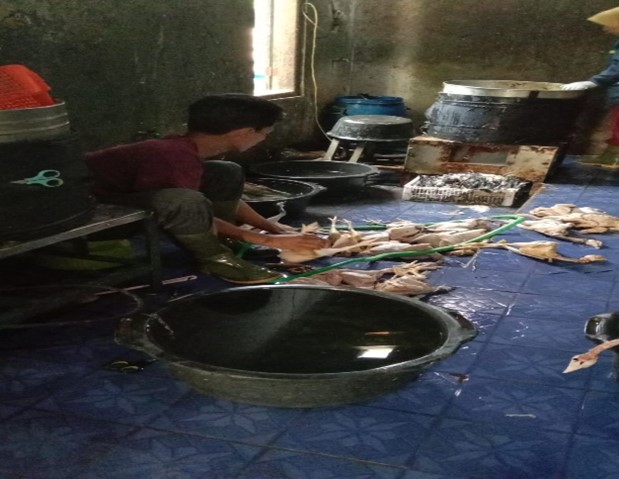Awareness of Chicken Slaughterhouse Business Actors Towards Halal Products
DOI:
https://doi.org/10.12962/j22759970.v4i1.1053Keywords:
Halal Awareness, Chicken Slaughterhouse, tipping point, halalAbstract
This study aims to provide an empirical picture of halal awareness of chicken slaughterhouse business actors towards halal certification in Indonesia by understanding halal perceptions and the extent of halal risks, critical points, and critical processes in their chicken slaughterhouses. This study uses a descriptive qualitative approach with field research methods. The research informants were two chicken slaughterhouse business actors: Mr. Wafir from RPA Semerak and Mr. Isa from RPA Master Chick. Data were obtained through interviews and documentation, with qualitative analysis using deductive methods. Planning Behavior Theory (SDG) is used to understand business actors' perceptions of halal certification, focusing on actual behavior, intentions, attitudes, and knowledge. The results showed that RPA Semerak already has awareness of halal production but does not have awareness of the obligation of halal certification, which is caused by the lack of public and business actors' understanding of the critical point and urgency of halal certification. In addition, tipping point activity related to chicken slicing after slaughter has not yet been considered. As for the RPA Master Chick, despite having awareness about halal certification, it still lacks a thorough understanding of knowledge. The results of this research are expected to contribute to increasing the understanding and awareness of chicken slaughterhouse business actors towards halal certification, as well as assisting related parties in designing education and training programs that are in accordance with the needs of the industry.
Downloads
References
Pusat Data dan Sistem Informasi Pertanian, “Outlook Komoditas Peternakan Daging Ayam Ras Pedagin,” 2022. [Online]. Available: satudata.pertanian.go.id/assets/docs/publikasi/Outlook_Ayam_Ras_Pedaging_2022_Final.pdf
K. Candra, “Forecasting Analysis of Production And Consumption of Ras Chicken Meat In Indonesia In Order To Make Food Security,” Majalah Teknologi Agro Industri, vol. 12, no. 2, 2020.
A. Fuseini, M. Miele, and J. Lever, Poultry Welfare at Slaughter. MPDI (Multidiciplinary Digital Publishing Institute.
H. Catur Wahyuni, “Food Safety and Halal Food Risks in Indonesian Chicken Meat Products,” International Conference on Industrial Engineering and Engineering Management (IEEM), 2008, [Online]. Available: 10.1109/IEEM.2018.8607528
K. Pufpaff, M. N. Riaz, and M. M. Chaudry, “Halal Production Requirements for Meat and Poultry,” in Handbook Halal Food Production, Florida: CRC Press Taylor & Francis Group, 2004.
A. Fuseini, Halal Slaughter of Livestock: Animal Welfare Science, History and Politics of Religios Slaughter. Australia: Springer, 2023.
A. Shahdan and J. M. Regenstein, “Developing Control Points for halal Slaughtering of Poultry,” Elseiver Poultry Science, vol. 95, no. 7, 2016.
D. Wahyuni, “Halal Risk Analysis at Indonesia Slaughterhouses Using The Suply Chain Operations Refrence and House of Risk Methods,” Dini Wahyuni, “Halal Risk Analysis at Indonesia Slaughterhouses Using The SupTalenta Journal of Physics Conference Series, vol. 1542, no. 1, 2020.
A. Akbar, “Halal Blockchain Application for a Chicken Slaughtering Factory,” International Journal on Food System Dynamics, vol. 13, no. 3, 2022.
W. J, Cluster Analysis and K-means Clustering. Springer, 2012.
Harwati, “Capturing Profile of Halal Chicken Meat Slaughterhouse,” Proceedings of the Second Asia Pacific International Conference on Industrial Engineering and Operations Management, 2021.
“SNI 990002 tahun 2016 tentang Pemotongan Halal pada Unggas,” Badan Standardisasi Nasional, Jakarta, 2016.
A. Utriza Yakin, “Halal Certification Standards and Their Ramifications in Belgium,” in Rethinking Halal: Genealogy, Current Trends, and New Interpretation, Leiden: Brill, 2021.
Sukoso, Ekosistem Industri Halal. Jakarta: Ekosistem Departemen Ekonomi dan Keungan Syariah Bank Indonesia, 2020.
A. J. Fitzgerald, “A Social History of the Slaughterhouse: From Inception to Contemporary Implications,” Human Ecology Review, vol. 17, no. 1, 2010.
“Keputusan Kepala Badan Penyelenggara Jaminan Produk Halal Nomor 57 Tahun 2021 Tentang Kriteria Sistem Jaminan Produk Halal,” Badan Penyelenggara Jaminan Produk Halal, 2021.
“Fatwa Majelis Ulama Indonesia Nomor 12 Tahun 2009 Tentang Standar Sertifikasi Penyembelihan Halal,” Majelis Ulama Indonesia, Jakarta, 2009.
“electrical waterbath stunning of poultry,” 2016. [Online]. Available: www.hsa.org.uk
Wafir, “Wawancara Pemilik Usaha RPA Semerak,” Jul. 01, 2023.
Isa, “Wawancara Pemilik Usaha RPA Master Chick,” Jul. 03, 2023.
Yunia, “Wawancara Penyuluh Desa di Kantor Urusan Keagamaan Margoyoso,” Jul. 03, 2023.
Fathul Inayah, “Wawancara Penyuluh Desa di Kantor Urusan Keagamaan Tayu,” Jul. 03, 2023.
M. K. Anwar, “The Urgency of Halal Assurance System for Product Reliability,” International Journal of Islamic Business and Economics, vol. 2, no. 2, p. 123, 2018.

Downloads
Published
How to Cite
Issue
Section
License
Copyright (c) 2024 basmah

This work is licensed under a Creative Commons Attribution-NonCommercial 4.0 International License.
Copyright
Authors who publish their manuscripts in this journal agree to the following terms:
- The copyright of each article remains with the authors.
- Halal Research Journal holds the right to publish the article first under the Creative Commons Attribution 4.0 International License.
- Authors may distribute their published manuscripts non-exclusively (e.g., to institutional repositories or as part of book publications), provided they acknowledge that the article was first published in this journal.
License
Articles published in this journal are licensed under the Creative Commons Attribution 4.0 International License. This license permits anyone to:
- Copy, distribute, adapt, modify, and create derivative works from the material in any form, including for commercial purposes.
- The condition is that proper credit must be given to the authors for the original work.










